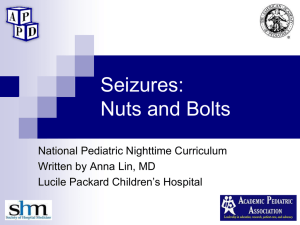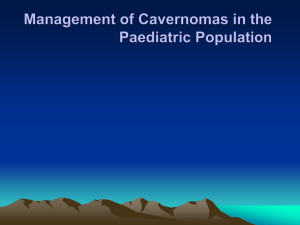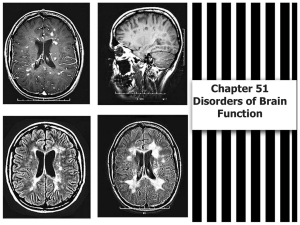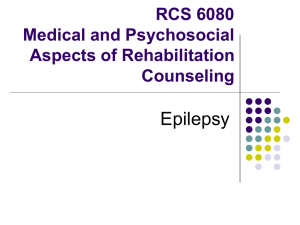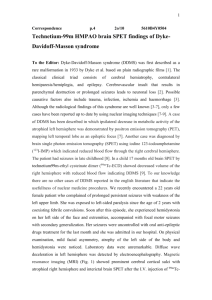PART E: EXPERIMENTAL DESIGN / PROTOCOL (all applicants
advertisement
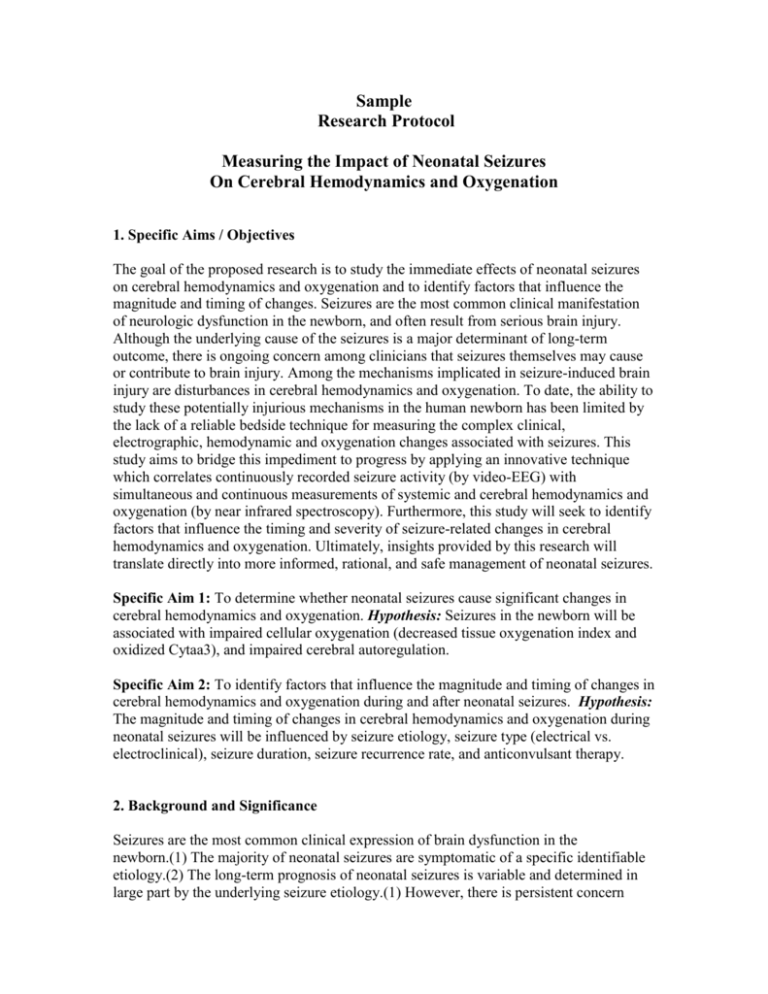
Sample Research Protocol Measuring the Impact of Neonatal Seizures On Cerebral Hemodynamics and Oxygenation 1. Specific Aims / Objectives The goal of the proposed research is to study the immediate effects of neonatal seizures on cerebral hemodynamics and oxygenation and to identify factors that influence the magnitude and timing of changes. Seizures are the most common clinical manifestation of neurologic dysfunction in the newborn, and often result from serious brain injury. Although the underlying cause of the seizures is a major determinant of long-term outcome, there is ongoing concern among clinicians that seizures themselves may cause or contribute to brain injury. Among the mechanisms implicated in seizure-induced brain injury are disturbances in cerebral hemodynamics and oxygenation. To date, the ability to study these potentially injurious mechanisms in the human newborn has been limited by the lack of a reliable bedside technique for measuring the complex clinical, electrographic, hemodynamic and oxygenation changes associated with seizures. This study aims to bridge this impediment to progress by applying an innovative technique which correlates continuously recorded seizure activity (by video-EEG) with simultaneous and continuous measurements of systemic and cerebral hemodynamics and oxygenation (by near infrared spectroscopy). Furthermore, this study will seek to identify factors that influence the timing and severity of seizure-related changes in cerebral hemodynamics and oxygenation. Ultimately, insights provided by this research will translate directly into more informed, rational, and safe management of neonatal seizures. Specific Aim 1: To determine whether neonatal seizures cause significant changes in cerebral hemodynamics and oxygenation. Hypothesis: Seizures in the newborn will be associated with impaired cellular oxygenation (decreased tissue oxygenation index and oxidized Cytaa3), and impaired cerebral autoregulation. Specific Aim 2: To identify factors that influence the magnitude and timing of changes in cerebral hemodynamics and oxygenation during and after neonatal seizures. Hypothesis: The magnitude and timing of changes in cerebral hemodynamics and oxygenation during neonatal seizures will be influenced by seizure etiology, seizure type (electrical vs. electroclinical), seizure duration, seizure recurrence rate, and anticonvulsant therapy. 2. Background and Significance Seizures are the most common clinical expression of brain dysfunction in the newborn.(1) The majority of neonatal seizures are symptomatic of a specific identifiable etiology.(2) The long-term prognosis of neonatal seizures is variable and determined in large part by the underlying seizure etiology.(1) However, there is persistent concern Mock Research Protocol – Cecil Hahn, MD among clinicians that neonatal seizures are not only a clinical manifestation of potentially severe brain injury, but may also independently contribute to brain injury. Since neonatal seizures are considered a neurological emergency, they are often treated aggressively with anticonvulsant medications. However, many neonatal seizures are refractory to conventional anticonvulsants, even at high doses of multiple agents.(3) The risk–benefit ratio of such high-dose, multi-drug regimens in critically ill infants has been questioned. Specifically, the potential for seizures to cause direct injury to the immature brain has to be weighed against the potential toxic effects (e.g., systemic hypotension) of high-dose anticonvulsants on the developing brain. These issues have triggered a vigorous but unresolved debate about the management of neonatal seizures. The research proposed here aims to address questions central to this controversy. The ability of neonatal seizures to cause direct brain injury remains controversial.(4-6) While some studies(4, 7) suggest that the immature brain is remarkably resistant to seizure-induced injury, other lines of evidence support the notion that seizures, particularly when prolonged or repeated, contribute independently to brain injury. In a neonatal rat model,(7) prolonged seizures triggered by proconvulsant drugs failed to cause neuropathological changes. However, when preceded by a hypoxicischemic insult, these drug-induced seizures were associated with significantly greater neuronal injury than hypoxia-ischemia alone. Of note, cerebral hypoxia-ischemia is the leading cause of seizures in the human newborn.(1) A number of causal mechanisms have been proposed for seizure-induced brain injury.(1) These include ‘excitotoxic’ injury due to massive accumulation of the excitatory neurotransmitter, glutamate.(8) Currently, the direct study of excitotoxic mechanisms at the infant’s bedside is not feasible. This research proposal focuses on another potentially important mechanism, i.e., seizure-related disruption of normal cerebral hemodynamics and energy supply. Evidence in support of this mechanism comes from in vivo studies in neonatal dogs, piglets and humans, where seizures have been shown to cause significant systemic and cerebral hemodynamic disturbances.(9, 10) These studies show that the initial, probably adaptive, hemodynamic response to seizures is a rapid increase in systemic arterial blood pressure and cerebral blood flow. However, when prolonged or repeated, seizures are associated with sustained impairment of cerebral autoregulation(11) and systemic hypotension due to impaired cardiac function.(12) In addition, the repeated neuronal depolarization-repolarization associated with seizures consumes massive amounts of cerebral energy. This combination of reduced cardiac output, systemic hypotension, impaired cerebral autoregulation and increased energy consumption constitutes a major risk for cerebral ischemic injury.(1) To date, there have been few attempts to characterize the immediate cerebral metabolic effects of seizures in the human newborn. In one study,(13) infants experiencing seizures during 31P-labelled magnetic resonance spectroscopy (31P-MRS) studies showed a marked decrease in cerebral high-energy phosphate concentration during and shortly after seizures; in some cases cerebral high-energy phosphates recovered rapidly after successful treatment with phenobarbital. Although 31P-MRS may provide important insights into the cerebral metabolic consequences of neonatal seizures, the need to transport infants to a scanner has limited its application to the prolonged study of critically ill infants. 2 Mock Research Protocol – Cecil Hahn, MD Near infrared spectroscopy (NIRS) is an innovative technique for the continuous, non-invasive bedside measurement of cerebral hemodynamics and oxygenation.(14, 15) This technique is based on the principle that light in the near-infrared range passes readily through skin, soft tissue and bone, allowing it to be transmitted into organs such as the brain. Once in the brain, the absorption of near-infrared light is determined by the concentration and oxygenation of two critical ‘chromophores’, i.e., hemoglobin and cytochrome aa3 (Cytaa3), the terminal enzyme in the mitochondrial electron transport chain. Changes in the absorption of near-infrared light at selected wavelengths therefore reflect changes in cerebral intravascular (hemoglobin) oxygenation and intracellular (Cytaa3) oxygenation. In this manner, NIRS makes quantitative measurements of changes in the cerebral concentration of oxygenated hemoglobin (HbO2), deoxygenated hemoglobin (Hb), and oxidized cytochrome aa3. Important information may be derived from these primary measurements. Changes in total hemoglobin (THb) concentration, and therefore in cerebral blood volume, are derived from the summation of changes in HbO2 and Hb. Conversely, changes in the difference between HbO2 and Hb (i.e., HbD) have shown a highly significant correlation with cerebral blood flow.(16, 17) In addition, the tissue oxygenation index (TOI) may be calculated from the ratio of HbO2 to THb. These unique features of NIRS have allowed continuous measurements of cerebral hemodynamics and oxygenation at the bedside of critically infants.(18-26) Although NIRS would appear to be an ideal technique for the study of the effects of seizures on cerebral metabolism and hemodynamics, reports of this application are few,(27-30) with no studies reported in the newborn. In one study using NIRS in older epileptic children,(30) several different patterns of changes in THb, HbO2 and Hb were associated with seizures, which was proposed to reflect the heterogeneity of seizure type and etiology (see Figure 1). This earlier study suggested a potential role for NIRS in the study of seizures. The current research proposal differs from the above study in important ways. First, our study will focus on seizures in the newborn infant, which were not included in the previous report. Second, we plan to study not only changes in cerebral hemodynamics, but also the more important changes in tissue oxygenation (TOI) and cellular oxygenation and energy status (Cytaa3).(31, 32) 3. Preliminary Studies / Progress Report Over the past decade, we have applied the NIRS technique to the measurement of cerebral hemodynamics and oxygenation in a number of animal(16, 17, 33-35) and clinical studies.(36-41) Validation studies in a neonatal piglet model showed a robust and highly significant association between changes in HbD and cerebral blood flow (CBF) (measured by the gold standard radioactive microsphere technique) during large changes in cerebral perfusion pressure induced by graded aortic ligature(16) or by changing intracranial pressure (using mock cerebrospinal fluid infusions).(17) In a neonatal rodent model of graded hypoxia, we demonstrated a highly significant correlation between changes in Cytaa3 and changes in high-energy phosphate compounds (measured by 31PMRS);(31) in fact, the decrease in Cytaa3 actually preceded that in high-energy phosphates. These findings were subsequently corroborated by others.(32) Our clinical studies in over 400 infants have demonstrated the feasibility and safety of using NIRS in critically ill infants in settings such as deep hypothermic infant 3 Mock Research Protocol – Cecil Hahn, MD cardiac surgery, extreme prematurity, infantile hydrocephalus, and perinatal asphyxia.(36-43) In recent years, we have developed a technique for evaluating the integrity of cerebral pressure autoregulation that uses rapid (2 Hz) simultaneous measurements of changes in blood pressure and cerebral HbD changes. These measurements are then subjected to coherence and transfer function analysis(40, 44-47) in order to delineate the relationship between the blood pressure and HbD signals. This approach will be used to study the effect of seizures on cerebral pressure autoregulation in the current proposal. In a recent review of all neonatal seizures occurring over a 3-year period at Children’s Hospital, Brigham and Women’s Hospital and Beth Israel Deaconess Hospital (manuscript submitted), we found an incidence of around 40 infants with neonatal seizures per year. We also found a wide range of seizure etiologies, including global hypoxia-ischemia (40%), arterial ischemic stroke (20%), intracranial hemorrhage (18%), cerebral dysgenesis (5%), infection (3%) and unknown/other (15%). This frequent occurrence and broad etiologic spectrum of neonatal seizures will be of major importance for accomplishing the goals of the proposed research. 4. Experimental Protocol Patient Selection and Inclusion/Exclusion Criteria This research will be conducted in the neonatal intensive care unit. All infants diagnosed with seizures by the attending neonatologist according to standardized criteria(48) during the first 30 days of life will be eligible for enrollment in this study. Gestational age at birth will not be a selection criterion, but extremely low birthweight infants may need to be excluded due to technical limitations or medical instability. Because the goal of the study is to measure the effects of seizures, treatment of seizures may be delayed until a satisfactory NIRS recording is obtained. However, we will make every effort to begin the study as soon as possible, in order to minimize any such treatment delay. Research Design This prospective observational cohort study aims to quantify the immediate effects of neonatal seizures on cerebral hemodynamics and oxygenation. The current management of most infants with seizures includes video-EEG monitoring. This study protocol will supplement these video-EEG recordings with simultaneous measurement of cerebral NIRS, and systemic parameters (heart rate, blood pressure, oxygen saturation) obtained directly from the bedside monitor. The study design for a hypothetical patient is outlined in Figure 2. One unique feature of this design is that patients will serve as their own controls for time intervals prior, during and after seizures (see below). The recording schedule for EEG and NIRS is illustrated in Figure 3. Although video-EEG recordings are routinely performed for a continuous 72hour period, the duration of NIRS recordings is currently limited to 12 hours per day because quality control necessitates the continuous presence of a technician at the 4 Mock Research Protocol – Cecil Hahn, MD bedside. Measurement of Exposures: Neonatal Seizures Neonatal seizures are the exposure of interest, and will be measured by continuous videoEEG monitoring (Ceegraph Biologic Systems) for a period of 72 hours. The video-EEG recordings will be interpreted independently by two neurophysiologists, who will be blinded to the patient’s identity, all clinical data, the NIRS data, and each other’s interpretations. The diagnosis and timing of seizures will based on review of the EEG tracing and the infant’s behavioral changes captured on video, according to standard diagnostic criteria.(1, 2) Any disagreement between the two neurophysiologists will be resolved by review of the data and formulation of a consensus opinion. Seizures will be classified as electroclinical (EEG seizures accompanied by clinical signs), clinical (clinical signs without EEG seizures) and electrical (EEG seizures without clinical signs). Seizures will also be classified by cortical location, duration, recurrence rate, and according to clinical signs according to the classification scheme of Volpe(1): Classification of Neonatal Seizures Subtle Clonic Focal Multifocal Tonic Focal Generalized Myoclonic Focal Multifocal Generalized Definition of Pre-ictal, Ictal and Post-ictal Time Intervals The period surrounding each seizure will be divided into time intervals based on the video-EEG data, indicating pre-ictal, ictal and post-ictal periods according to the definitions illustrated in Figure 4. The timing of these definitions is based on NIRS measurements from previous studies conducted in non-neonates, and thus their applicability to the neonatal study population has not been tested. Therefore, these definitions will be evaluated and revised based on exploratory analyses of the data from the first five subjects with usable NIRS data. Measurement of Outcomes: NIRS Data and Systemic Parameters The outcome of interest is an alteration in the NIRS signal during seizures, specifically the change in Cytochrome aa3, tissue oxygenation index, and the integrity of cerebral autoregulation. To measure these outcomes, continuous NIRS recordings (NIRO 300A spectrophotometer, Hamamatsu Photonics) will be performed for 12 hours per day on each of the three study days (which represents the maximum technically feasible recording time). NIRS signals will be recorded simultaneously from both left and right cerebral hemispheres. In addition, heart rate, mean arterial blood pressure and oxygen 5 Mock Research Protocol – Cecil Hahn, MD saturation will be recorded concurrently from the subject’s routine bedside monitor (Marquette Solar 8000). Measurement of Covariables The following covariables will be recorded in order to permit adjustment for their possible confounding or effect modification of the association between seizures and NIRS signal changes. Covariables will be recorded in a structured manner at the time of enrollment and on each subsequent study day. Demographic characteristics (i.e. gestational age, weight, family history of epilepsy) will be obtained from patient records. Perinatal history will be obtained from labor and delivery records. Stringent criteria will be used for the diagnosis of perinatal asphyxia.(49) Medications (i.e. antiepileptic drugs, inotropes): dosage will be obtained from flow sheets; precise timing of medication administration will be obtained from flow sheets and by observation of the patient video. Structural brain injury (infarction, epidural/subdural/intraparenchymal hemorrhage, meningitis/encephalitis, hydrocephalus) or brain malformation will be recorded from cranial ultrasound, CT, and MRI reports. Comorbidities, such as meningitis, sepsis, genetic syndromes, electrolyte disturbances will be noted based on clinical records and laboratory data. Routine Clinical Care of Subjects Throughout the study, infants will continue to receive their usual clinical care once sufficient baseline seizure recordings have been obtained. In particular, any seizures will be managed according to a standardized protocol in a Manual of Neonatal Care(48) used in the NICU. 5. Interpretation of Data Characterization of NIRS Data The NIRS data from each patient will consist of four paired series of signals for both left and right cerebral hemispheres: oxygenated hemoglobin (HbO2), deoxygenated hemoglobin (Hb), tissue oxygenation index (TOI) and oxidized cytochrome aa3 (Cytaa3). Each of the NIRS signals will be recorded during three 12-hour intervals over a 72 hour period (Figure 3). Two additional series will be derived from these signals: total hemoglobin (THb=HbO2+Hb) and the difference between oxygenated and deoxygenated hemoglobin (HbD=HbO2-Hb). Finally, a relative TOI will be derived by calculating the ratio of TOI divided by systemic oxygen saturation. Primary Outcomes: For each series of NIRS data, mean values will be calculated during each of the pre-defined time intervals (see Figure 4): early pre-ictal, immediate pre-ictal, ictal, immediate post-ictal and late post-ictal. The mean NIRS value for each interval will be determined by the sum of all measured data points during that interval, divided by number of measured data points during that interval. 6 Mock Research Protocol – Cecil Hahn, MD Secondary Outcome: In a subset of patients who have arterial lines in place, we will examine the correlation between mean arterial blood pressure and HbD signals by coherence and transfer function analysis in order to assess the integrity of cerebral autoregulation.(40, 44-47) Each time interval will be classified as having intact or impaired cerebral autoregulation according to whether the coherence score is <0.50 or 0.50, respectively. Statistical Analysis Plan Primary analyses will focus on changes from baseline (early pre-ictal mean) in the NIRS signals for Cytochrome aa3 and tissue oxygenation index. For both of these measures, a one-sample test of difference from the baseline value will be conducted for each of the ictal and post-ictal time intervals. If the data appear normally distributed, or can be transformed to achieve approximate normality, the one-sample t-test will be used. Otherwise, the nonparametric Wilcoxon signed rank test will be used. A secondary analysis will be performed when electrographic seizure activity may be lateralized to one hemisphere. These lateralized seizures provide an opportunity to control for the systemic hemodynamic effects of seizures (i.e. on blood pressure and heart rate) by subtracting the NIRS signals from the unaffected hemisphere from the signals from the affected hemisphere. We hypothesize that the resultant ‘adjusted’ NIRS signals may more accurately represent the local effects of seizures on cerebral hemodynamics and oxygenation. Characteristics of the seizure and of seizure history, such as seizure etiology, duration of seizure, type of seizure (electrographic only versus electroclinical), and number of known prior seizures will be assessed for their associations with the NIRS measures using correlation, ANOVA or nonparametric analogues as appropriate. For cases when multiple seizures are captured in a single subject, generalized estimating equations (GEE) will be used to account for correlated observations. Statistical Power The primary analyses will compare NIRS signals during and after seizures with the baseline level prior to the seizure within the same patient. These are essentially one-sample tests against a mean of zero. Therefore, the relevant power calculations are for one-sample tests. Assuming a two-sided type I error of 0.05, the following table illustrates how small an effect size can be detected with 85% power, for a range of sample sizes, where effect size is the change from baseline measured in standard deviation units. The table assumes one seizure recorded per subject. Effect size: Sample size: .40 57 .50 36 .60 25 .70 19 .90 12 1.0 9 7 Mock Research Protocol – Cecil Hahn, MD Based on a recent review of all neonatal seizures at Children’s Hospital Boston, Brigham and Women’s Hospital and Beth Israel Deaconess Hospital (see preliminary studies) we estimate an incidence of approximately 30 neonatal seizures per year at the two study sites. Assuming that 75% of families approached will choose to participate, we estimate enrollment of approximately 40 patients over the two-year study period. Given that data from five patients will be used for the initial exploratory analysis, and approximately 510 patients will yield no usable NIRS data (for example because no seizures were captured by NIRS), we anticipate that approximately 25-30 patients will yield analyzable data. The table above given this estimated sample size, effect sizes of between 0.5 and 0.6 standard deviations, or higher, will be detected with 85% power. Patients who contribute more than one seizure will increase the power (or equivalently, decrease the detectable effect size) but it is difficult to project the magnitude of improvement in precision without knowing how highly correlated the within-subject responses will be across seizures. 6. Risks There are no reported risks or discomforts associated with video-EEG or neonatal NIRS. We have studied over 300 critically ill infants with NIRS and to date have experienced no significant adverse effects. There is potential risk for allergy to the tape applying the optodes to the infant’s skin. Should this occur, an alternative fixation technique will be applied. 7. Potential Benefits Benefits to study participants: Study subjects are unlikely to receive direct potential benefit from participation in this protocol, however the NIRS data generated during the study period may be used for clinical decision-making. Advancement of scientific knowledge: The ability to make precisely time-locked quantitative measurements of cerebral hemodynamics, vasoregulation, and oxygenation at the bedside of sick infants with seizures will present a major opportunity for advancing our understanding of neonatal seizures and their consequences. Simultaneous measurement of changes in the EEG, systemic parameters and cerebral perfusion and oxygenation will provide new insights into the temporal relationships between these changes. Comparing the hemodynamic responses to seizures of different etiologies will increase our understanding of the relationship between etiology and long-term outcome. Data generated by this research will also be critical for the design of future studies into the long-term significance of these acute seizure-induced changes in cerebral perfusion and oxygenation. Benefits to society: This study is motivated by the current vigorous but unresolved debate about the optimal management of neonatal seizures. Ultimately, insights provided 8 Mock Research Protocol – Cecil Hahn, MD by this research will translate directly into more informed, rational, and safe management of neonatal seizures, with enormous potential benefit to society. 8. References 1. 2. 3. 4. 5. 6. 7. 8. 9. 10. 11. 12. 13. 14. 15. 16. 17. 18. 19. 20. 21. Volpe JJ. Neonatal seizures. In: Neurology of the Newborn. Philadelphia: WB Saunders; 2001. p. 178-214. Mizrahi EM, Kellaway P. Diagnosis and Management of Neonatal Seizures. Philadelphia: Lippincott-Raven; 1998. Painter MJ, Scher MS, Stein AD, Armatti S, Wang Z, Gardiner JC, et al. Phenobarbital compared with phenytoin for the treatment of neonatal seizures. N Engl J Med 1999;341(7):485-9. Camfield PR. Recurrent seizures in the developing brain are not harmful. Epilepsia 1997;38(6):735-7. Wasterlain CG. Recurrent seizures in the developing brain are harmful. Epilepsia 1997;38(6):72834. Holmes G. Do seizures cause brain damage? Epilepsia 1991;32(Suppl 5):S14-S28. Wirrell EC, Armstrong EA, Osman LD, Yager JY. Prolonged seizures exacerbate perinatal hypoxic-ischemic brain damage. Pediatr Res 2001;50(4):445-54. Holmes GL, Ben-Ari Y. The neurobiology and consequences of epilepsy in the developing brain. Pediatr Res 2001;49(3):320-5. Clozel M, Daval JL, Monin P, Dubruc C, Morselli PL, Vert P. Regional cerebral blood flow during bicuculline-induced seizures in the newborn piglet: effect of phenobarbital. Dev Pharmacol Ther 1985;8(3):189-99. Perlman JM, Herscovitch P, Kreusser KL, Raichle ME, Volpe JJ. Positron emission tomography in the newborn: effect of seizure on regional cerebral blood flow in an asphyxiated infant. Neurology 1985;35(2):244-7. Hascoet JM, Monin P, Vert P. Persistence of impaired autoregulation of cerebral blood flow in the postictal period in piglets. Epilepsia 1988;29(6):743-7. Young RS, Fripp RR, Yagel SK, Werner JC, McGrath G, Schuler HG. Cardiac dysfunction during status epilepticus in the neonatal pig. Ann Neurol 1985;18(3):291-7. Younkin DP, Delivoria-Papadopoulos M, Maris J, Donlon E, Clancy R, Chance B. Cerebral metabolic effects of neonatal seizures measured with in vivo 31P NMR spectroscopy. Ann Neurol 1986;20(4):513-9. Soul JS, du Plessis AJ. New technologies in pediatric neurology. Near-infrared spectroscopy. Semin Pediatr Neurol 1999;6(2):101-10. du Plessis A. Near-infrared spectroscopy for the in vivo study of cerebral hemodynamics and oxygenation. Current Opinion in Pediatrics 1995;7:632-639. Tsuji M, duPlessis A, Taylor G, Crocker R, Volpe JJ. Near infrared spectroscopy detects cerebral ischemia during hypotension in piglets. Pediatr Res 1998;44(4):591-5. Soul JS, Taylor GA, Wypij D, Duplessis AJ, Volpe JJ. Noninvasive detection of changes in cerebral blood flow by near-infrared spectroscopy in a piglet model of hydrocephalus. Pediatr Res 2000;48(4):445-9. Meek J, Elwell C, McCormick D, Edwards A, Townsend J, Stewart A, et al. Abnormal cerebral haemodynamics in perinatally asphyxiated neonates related to outcome. Arch Dis Child Fetal Neonatal Ed 1999;81:F110-F115. Patel J, Marks K, Roberts I, Azzopardi D, Edwards AD. Measurement of cerebral blood flow in newborn infants using near infrared spectroscopy with indocyanine green. Pediatr Res 1998;43(1):34-9. Liem K, Hopman J, Oeseberg B, de Haan A, Festen C, Kollee L. Cerebral oxygenation and hemodynamics during induction of extracorporeal membrane oxygenation as investigated by near infrared spectroscopy. Pediatrics 1995;95(4):555-561. Brun N, Greisen G. Cerebrovascular response to carbon dioxide as detected by near-infrared spectroscopy: Comparison of three different measures. Pediatr Res 1994;36(1):20-24. 9 Mock Research Protocol – Cecil Hahn, MD 22. 23. 24. 25. 26. 27. 28. 29. 30. 31. 32. 33. 34. 35. 36. 37. 38. 39. 40. 41. 42. van Bel F, Dorrepaal C, Benders M, Zeeuwe P, van de Bor M, Berger H. Changes in cerebral hemodynamics and oxygenation in the first 24 hours after birth asphyxia. Pediatrics 1993;92(3):365-372. Skov L, Ryding J, Pryds O, Greisen G. Changes in cerebral oxygenation and cerebral blood volume during endotracheal suctioning in ventilated neonates. Acta Paediatr 1992;81(5):389-93. Wyatt J, Edwards A, Cope M, Delpy D, McCormick D, Potter A, et al. Response of cerebral blood volume to changes in arterial carbon dioxide tension in preterm and term infants. Pediatr Res 1991;29:553-557. Wyatt J, Delpy D, Cope M, Wray S, Reynolds E. Quantification of cerebral oxygenation and hemodynamics in sick newborn infants by near infrared spectroscopy. Lancet 1986;ii:1063-1066. Wyatt J, Cope M, Delpy D, Richardson C, Edwards A, Wray S, et al. Quantitation of cerebral blood volume in newborn human infants by near infrared spectroscopy. J Appl Physiol 1990;68:1086-1091. Steinhoff BJ, Herrendorf G, Kurth C. Ictal near infrared spectroscopy in temporal lobe epilepsy: a pilot study. Seizure 1996;5(2):97-101. Watanabe E, Maki A, Kawaguchi F, Yamashita Y, Koizumi H, Mayanagi Y. Noninvasive cerebral blood volume measurement during seizures using multichannel near infrared spectroscopic topography. J Biomed Opt 2000;5(3):287-90. Adelson PD, Nemoto E, Scheuer M, Painter M, Morgan J, Yonas H. Noninvasive continuous monitoring of cerebral oxygenation periictally using near-infrared spectroscopy: a preliminary report. Epilepsia 1999;40(11):1484-9. Haginoya K, Munakata M, Kato R, Yokoyama H, Ishizuka M, Iinuma K. Ictal cerebral haemodynamics of childhood epilepsy measured with near-infrared spectrophotometry. Brain 2002;125(Pt 9):1960-71. Tsuji M, Naruse H, Volpe J, Holtzman D. Reduction of cytochrome aa3 measured by near-infrared spectroscopy predicts cerebral energy loss in hypoxic piglets. Pediat Res 1995;37(3):253-259. Matsumoto H, Oda T, Hossain MA. Does the redox state of cytochrome aa3 reflect brain energy level during hypoxia? Simultaneous measurements by near infrared spectrophotometry and 31P nuclear magnetic resonance spectroscopy. Anesthesia & Analgesia 1996;83(3):513-518. Hiramatsu T, Miura T, Forbess J, du Plessis A, Aoki M, Nomura F, et al. pH strategies and cerebral energetics before and after circulatory arrest. J Thorac Cardiovasc Surg 1995;109:948958. Shin'oka T, Shum-Tim D, Jonas RA, Lidov HG, Laussen PC, Miura T, et al. Higher hematocrit improves cerebral outcome after deep hypothermic cirulatory arrest. J Thorac Cardiovasc Surg 1996;112(6):1610-1620. Miura T, Laussen P, Lidov HG, DuPlessis A, Shin'oka T, Jonas RA. Intermittent whole-body perfusion with "somatoplegia' versus blood perfusate to extend duration of circulatory arrest. Circulation 1996;94(9 Suppl):II56-62. du Plessis A, Newburger J, Jonas R, Hickey P, Naruse H, Tsuji M, et al. Cerebral oxygen supply and utilization during infant cardiac surgery. Ann Neurol 1995;37:488-497. du Plessis A, Tsuji M, Naruse H, Volpe J. Near infrared spectroscopy (NIRS) shows pronounced effects of CSF removal on cerebral hemodynamics in infantile hydrocephalus. Pediatr Res 1995;37:377A. du Plessis AJ, Newburger J, Jonas RA, Wessel DL, Wypij D, Tsuji MK, et al. Cerebral CO2 vasoreactivity is impaired in the early postoperative period following hypothermic infant cardiac surgery. Europ J Neurol 1995;2(Suppl 2):68A. Tsuji M, du Plessis A, Eichenwald E, Naruse H, Volpe J. Cerebral oxygenation correlates with mean arterial pressure in critically ill premature infants. Pediatr Res 1995;37:241A. Tsuji M, Saul JP, du Plessis A, Eichenwald E, Sobh J, Crocker R, et al. Cerebral intravascular oxygenation correlates with mean arterial pressure in critically ill premature infants. Pediatrics 2000;106(4):625-32. Soul JS. Compression tests in infantile posthemorrhagic hydrocephalus identify cerebral hemodynamic compromise (abstr). Ann Neurol 2001;50 Suppl 1(3):S121. du Plessis A, Newburger J, Naruse H, al. e. Near-infrared spectroscopy (NIRS) during hypothermic cardiac surgery suggests impaired mitochondrial function. Ann Neurol 1993;34(3):442-443 (Abst). 10 Mock Research Protocol – Cecil Hahn, MD 43. 44. 45. 46. 47. 48. 49. Soul JS, Wypij D, Walter GL, du Plessis AJ. Cerebral oxygen vasoreactivity in critically ill infants (abstr). Ann Neurol 1998;44(3):535. Saul JP, Berger RD, Albrecht P, Stein SP, Chen MH, Cohen RJ. Transfer function analysis of the circulation: unique insights into cardiovascular regulation. Am J Physiol 1991;261(4 Pt 2):H123145. Saul JP, Berger RD, Chen MH, Cohen RJ. Transfer function analysis of autonomic regulation. II. Respiratory sinus arrhythmia. Am J Physiol 1989;256(1 Pt 2):H153-61. Zhang R, Zuckerman JH, Giller CA, Levine BD. Transfer function analysis of dynamic cerebral autoregulation in humans. Am J Physiol 1998;274:H233-H241. Giller CA. The frequency-dependent behavior of cerebral autoregulation. Neurosurgery 1990;27(3):362-368. du Plessis AJ. Neonatal Seizures. In: Cloherty J, Stark A, editors. Manual of Neonatal Care. 5th ed. Philadelphia: Lippincott-Raven; (In press). du Plessis AJ. Perinatal asphyxia and hypoxic-ischemic encephalopathy in the term infant. In: Spitzer AR, editor. Intensive Care of the Fetus and Newborn. St. Louis: Mosby-Year Book; In press. Figure 1: Example of the NIRS signal recorded during a secondarily generalized tonic-clonic seizure in a 10-year old boy. Haginoya K, et al. Brain 2002;125:1960-1971. 11 Mock Research Protocol – Cecil Hahn, MD Figure 2: Overall Study Design for a Hypothetical Patient Time Intervals of Interest Begin EEG/NIRS Pre-Ictal 1st seizure Ictal Post-Ictal Time 2nd seizure +/- AED Treatment +/- AED Treatment Figure 3: Timing of EEG and NIRS Recordings EEG Recording: NIRS Recording: Enrollment 12 hrs 24 hrs 36 hrs 48 hrs 60 hrs Time 12 72 hrs Mock Research Protocol – Cecil Hahn, MD Figure 4: Definition of Pre-ictal, Ictal and Post-ictal Time Intervals 5 min 5 min Seizure 5 min 5 min Time Early pre-ictal Early Pre-ictal: Immediate Pre-ictal: Ictal: Immediate Post-ictal: Late Post-ictal: Immediate pre-ictal Immediate post-ictal Late post-ictal The 5 minute interval beginning 10 minutes before seizure onset The 5 minute interval immediately preceding seizure onset The interval from seizure onset to seizure termination The 5 minute interval immediately following seizure termination The 5 minute interval beginning 5 minutes following seizure termination 13 CONSENT FORM Participant’s Name: ________________________________________ Date: _____ Date of Birth: _____________________________________________ Age: ______ Project Title: Measuring the Impact of Neonatal Seizures on Cerebral Hemodynamics and Oxygenation DESCRIPTION AND EXPLANATION OF RESEARCH: We would like to ask you and your infant to participate in a research study being performed by the Department of Neurology. We have identified your infant as a potential participant in this study through a review of admissions to the Hospital. Your infant has recently been diagnosed with seizures. Seizures are a common result of a number of conditions in the newborn; however, there is a great deal we do not know about how seizures affect the blood flow and oxygen levels in an infant’s brain. The goal of this research study is to improve our understanding of the effects of seizures on an infant’s brain and to help future doctors provide better care for babies with seizures. We would like your permission to use an experimental technique called near infrared spectroscopy (NIRS) to measure the blood flow and oxygen level in your baby’s brain. Near Infrared Spectroscopy (NIRS) The NIRS technique involves attaching two pairs of tiny sensors to your baby’s skin, held in place by a stretchy cloth. Through one disc a special type of light shines into the brain. The second disc collects and measures the light that is reflected from the brain. All that passes into the brain during this test is near infrared light, similar to the red light used to measure oxygen at your baby’s fingertip or toe. The NIRS measurements for this study will be made for 12-hour periods on each of the next three days. At the same time that the NIRS measurements are being made, we will also record changes in your baby’s blood pressure taken directly from the monitors already in use by your baby’s doctor to monitor blood pressure and heart rate. If you agree to enroll your baby in this study, we will collect a variety of information on your baby. We will obtain some of the information we need from the tests that are routinely used in the care of babies such as yours who are experiencing seizures. Some of this routine information will come from your baby’s medical record, and some of it will come directly from the video-EEG and bedside monitors routinely used by doctors to manage babies such as yours. Although the near infrared spectroscopy (NIRS) is a research technique, we may also use this information to help treat your baby’s seizures. Throughout the study, your baby will continue to receive his/her routine clinical care. However, because our aim is to capture seizures, we may slightly delay your baby’s treatment until we have captured a minimum number of seizures to analyze using NIRS. Study Duration If you consent to your baby’s participation, then we will begin the study within the next 12 hours. The duration of the study will be 72 hours, during which we will collect EEG, NIRS and clinical information on your baby as described above. Once the study has begun, it will only be stopped in the case of severe medical risk, as defined by your baby’s neonatologist. We will not discharge your child from hospital before completion of the study. EXPENSES/COMPENSATION/REIMBURSEMENT: If you choose to participate, we will be pleased to offer you a gift or cash payment of $100. There will be no extra cost to you or your insurance carrier for the near infrared spectroscopy (NIRS) studies. Only those tests that are currently routinely performed for babies experiencing seizures (such as the video-EEG) will be charged to you or your insurance carrier. RISKS AND DISCOMFORTS: Because this is a monitoring study that does not make use of any drugs or invasive procedures, there are few foreseeable risks and discomforts. In order to capture seizures, it may be necessary to delay treatment of your baby’s seizures to perform optimal NIRS recordings. There are no reported risks or discomforts associated with the NIRS technique. We have studied over 300 critically ill infants with NIRS and to date have experienced no adverse effects from this technique. POTENTIAL BENEFITS: Although the NIRS measurements made during the study are for research purposes, they may also provide valuable information that can help us provide optimal care for your baby. It is hoped that the information gathered during this study will advance scientific understanding of any changes that occur in an infant’s brain because of seizures, and might also help us learn how to better manage infants who experience seizures. CONFIDENTIALITY: All of the information gathered as part of this study will be kept confidential. Your baby will be assigned a study number that will identify your baby with the data that is collected. Only the investigators involved in this study will have access to the information that links your baby’s study number to your baby’s name or medical record number. Your baby will not be identified in any publication that may result from this study. ALTERNATIVES: Your participation in this study is entirely voluntary. You have the alternative not to participate in this study. Your refusal to participate in this study will in no way interfere with any current or future care your child receives at the Hospital. INVESTIGATOR’S AND/OR ASSOCIATE’S STATEMENT: I have fully explained to ____________________________________________ the participant/parent/guardian nature and purpose of the above-described procedures and the risks involved in its performance. I will inform the participant of any changes in the procedures or the risks and benefits if any should occur during or after the course of the study. I have given a copy of the consent/authorization form to the subject/family. __________ Date ___________________________________ Investigator’s and/or Associate’s Signature CONSENT/AUTHORIZATION: I have been satisfactorily informed of the above-described procedure with its possible risks and benefits, and I have been given a copy of this form. ________ Date ______________________________________ Signature of Parent/Guardian _______________ Relationship
